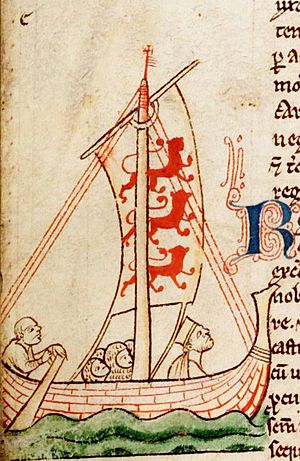English invasion of France (1230) facts for kids
Quick facts for kids English invasion of France of 1230 |
|||||||
|---|---|---|---|---|---|---|---|
| Part of the Capetian–Plantagenet rivalry | |||||||
|
|||||||
| Belligerents | |||||||
The English invasion of France in 1230 was a military campaign. It was led by Henry III of England. He wanted to get back lands in France that his family used to own. These lands were lost before 1224. The English army did not try to fight the French. They did not go into Duchy of Normandy. Instead, they marched south to the County of Poitou. The campaign in France did not go well. Henry made a peace agreement with Louis IX of France. Then he went back to England. Because the campaign failed, Hubert de Burgh, 1st Earl of Kent was removed from his important job as Justiciar (a chief royal officer).
Contents
Why the Invasion Happened
The future of Henry's family lands in France was still unclear. Getting these lands back was very important to Henry. He often talked about "reclaiming his inheritance" and "restoring his rights." He also spoke of "defending his legal claims" to these areas.
The French kings had more money and a stronger army than Henry. Even when Henry's father, King John, was alive, France had more resources. But since then, France's power grew even more. Their yearly income almost doubled between 1204 and 1221.
A Young French King
Louis VIII died in 1226. His son, Louis IX, was only 12 years old. A group of people ruled France for him. This was called a regency government. The young French King was not as strong as his father. Many French nobles did not like him. They still had ties to England. This led to many revolts across France.
Because of this, in late 1228, some nobles from Normandy and Anjou asked Henry to invade. They wanted him to take back his family lands. Also, Peter de Dreux, Duke of Brittany, openly rebelled against Louis. He swore loyalty to Henry.
The Invasion Begins
Henry left Portsmouth with a large army on April 30, 1230. They sailed to Guernsey and stayed there on May 2. The next day, May 3, the English army landed at Saint-Malo. There, Peter de Dreux, Duke of Brittany, met Henry.
On May 8, Henry went to Dinan and then to Nantes. He hoped to meet his mother, Isabella of Angoulême, there. He also wanted to meet her new husband, Hugh X of Lusignan, Count of La Marche.
French Resistance
A French army marched to Angers. They wanted to stop the English army from entering the County of Poitou. Henry stayed in Nantes, waiting for more soldiers. The French army moved to Oudon, a castle near Nantes.
Many nobles from Brittany swore loyalty to Henry. But some nobles made their castles stronger against him. Most lords from Poitou also swore loyalty. However, Hugh X of Lusignan, Count of La Marche, was unsure. Guy I, Viscount of Thouars, sided with Louis.
Marching Through France
Towards the end of June, the French army was busy elsewhere. Henry marched through the County of Anjou. He took the castle of Mirebeau in late July. Then he went into the County of Poitou. From there, he marched into the Duchy of Gascony. Many nobles there swore loyalty to him.
After this, he marched back to Brittany. He stayed for several weeks at Nantes. Finally, he returned to England, landing at Portsmouth on October 27, 1230. He left a small group of soldiers behind. These soldiers were led by Peter de Dreux, Duke of Brittany, and Ranulf de Blondeville, Earl of Chester. Their job was to fight the French in Normandy and Brittany.


